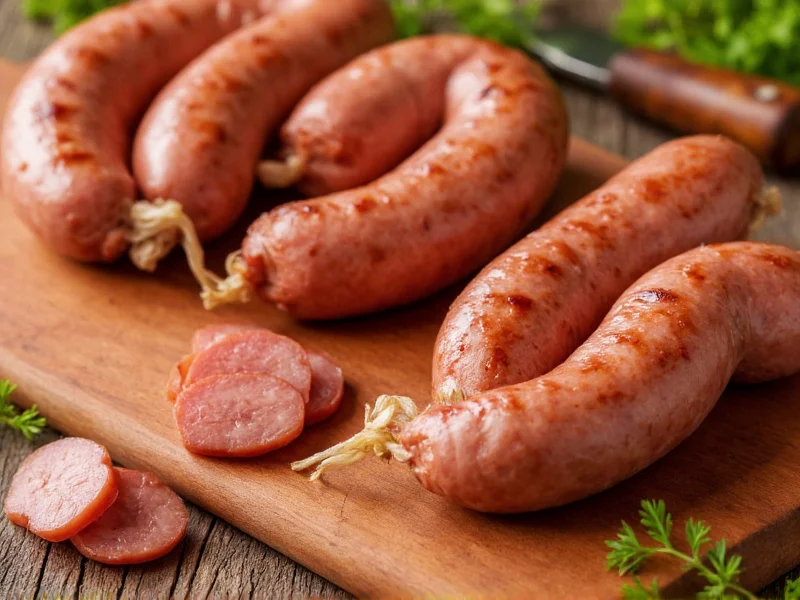The Ultimate Guide to Making Authentic Bratwurst at Home
Creating genuine German bratwurst from scratch transforms ordinary ingredients into a culinary masterpiece. Unlike store-bought versions, homemade bratwurst delivers superior flavor and texture when prepared with attention to traditional techniques. This comprehensive guide walks you through every step of the process, ensuring restaurant-quality results in your own kitchen.
Essential Ingredients for Traditional Bratwurst
The magic of authentic bratwurst lies in its simple yet precise ingredient composition. Quality matters most when selecting components for your homemade bratwurst sausage recipe.
| Ingredient | Quantity | Notes |
|---|---|---|
| Pork shoulder (Boston butt) | 2.5 lbs (70% lean) | Chilled to 35°F (2°C) before grinding |
| Back fat or pork fatback | 0.5 lbs | Essential for proper moisture and texture |
| Ice-cold water | ½ cup | Maintains low temperature during mixing |
| Finely ground sea salt | 1½ tbsp | Crucial for protein extraction |
| Freshly ground white pepper | 1½ tsp | Avoid pre-ground pepper for best flavor |
| Dried marjoram | 1 tsp | Authentic German bratwurst signature |
| Freshly grated nutmeg | ½ tsp | Use whole nutmeg for superior taste |
| Onion powder | 1 tsp | Traditional but optional |
| Natural hog casings | 1 pack (approx. 3m) | Soaked in water before use |
Equipment Checklist for Homemade Sausage Making
Proper equipment ensures consistent results for your traditional German bratwurst ingredients preparation:
- Meat grinder with fine plate attachment (3mm)
- Sausage stuffer (stand mixer attachment or manual)
- Sharp boning knife and cutting board
- Large stainless steel mixing bowl
- Kitchen scale for precise measurements
- Thermometer to monitor meat temperature
- Twine or sausage pricker for air bubbles
Step-by-Step Bratwurst Preparation Process
Follow these critical steps for perfect how to make bratwurst from scratch results:
1. Temperature Control is Crucial
Chill all equipment and ingredients to 35°F (2°C) before beginning. Warm meat causes fat to smear during grinding, resulting in poor texture. Place meat grinder parts in freezer for 30 minutes prior to use.
2. Precise Meat Preparation
Cut pork shoulder and fat into 1-inch cubes. Remove any sinew or connective tissue. Return cubed meat to refrigerator until ready to grind.
3. First Grinding Pass
Grind meat and fat through coarse plate (4.5mm) into chilled bowl over ice. Work quickly to maintain low temperature. If meat approaches 40°F (4°C), return to freezer for 10 minutes.
4. Seasoning and Mixing
Add all seasonings and ice water to ground meat. Mix vigorously for 3-4 minutes until sticky and emulsified. Proper mixing develops proteins that bind the sausage. Test by frying a small patty to check seasoning.
5. Final Grinding
Pass mixture through fine grinding plate (3mm) directly into mixing bowl over ice. This creates the characteristic smooth bratwurst texture.
6. Casing Preparation
Rinse natural hog casings thoroughly under cold water. Flush inside with water to remove salt. Soak in fresh water for 30 minutes before stuffing.
7. Stuffing Technique
Thread casing onto stuffer tube, leaving 4-inch tail. Fill casing gradually, applying even pressure to avoid air pockets. Don't overfill - sausage should feel firm but not tight. Twist into 6-inch links.
Perfect Cooking Methods for Bratwurst
Master these best cooking methods for bratwurst to achieve optimal results:
Traditional German Preparation
Gently poach bratwurst in simmering (not boiling) beer or broth at 160-170°F (71-77°C) for 10-12 minutes. This ensures thorough cooking without splitting casings. Finish with brief grill or pan sear for color.
Grilling Technique
Use two-zone fire with indirect heat first. Cook over indirect heat for 15 minutes, then move to direct heat for 3-4 minutes per side until golden brown. Never pierce sausages while cooking.
Pan-Frying Method
Heat cast-iron skillet over medium-low. Add ¼ inch water, cover, and cook 12 minutes. Remove lid, increase heat slightly, and brown for 3-4 minutes, turning occasionally.
Serving Authentic Bratwurst
Traditional German bratwurst serving suggestions include:
- Served in a crusty roll with sweet German mustard
- Accompanied by sauerkraut and potato salad
- Paired with dark beer or Apfelschorle (apple spritzer)
- Garnished with fried onions for Nuremberg-style presentation
Common Mistakes to Avoid
Prevent these frequent errors when attempting your authentic bratwurst preparation techniques:
- Temperature neglect - Meat warming above 40°F (4°C) during preparation
- Overmixing - Causes tough texture; stop when mixture becomes sticky
- Overstuffing casings - Leads to bursting during cooking
- Rushing the poaching step - Results in split casings when grilling
- Using hot water - Causes fat to melt prematurely
Variations on Traditional Bratwurst
While purists prefer the classic recipe, these homemade sausage making equipment-friendly variations offer delicious alternatives:
- Chicken Bratwurst - Substitute half pork with chicken thigh meat
- Beer-Infused Bratwurst - Replace water with reduced dark beer
- Apple Bratwurst - Add ¼ cup finely grated tart apple
- Spicy Bratwurst - Include ½ tsp cayenne pepper (not traditional but popular)
Storage and Freezing Guidelines
Proper storage maintains quality of your homemade bratwurst sausage recipe:
- Refrigerate uncooked bratwurst up to 2 days in airtight container
- Freeze raw links individually on baking sheet, then transfer to freezer bags
- Vacuum sealing extends freezer life to 6 months
- Thaw frozen bratwurst in refrigerator 24 hours before cooking











 浙公网安备
33010002000092号
浙公网安备
33010002000092号 浙B2-20120091-4
浙B2-20120091-4